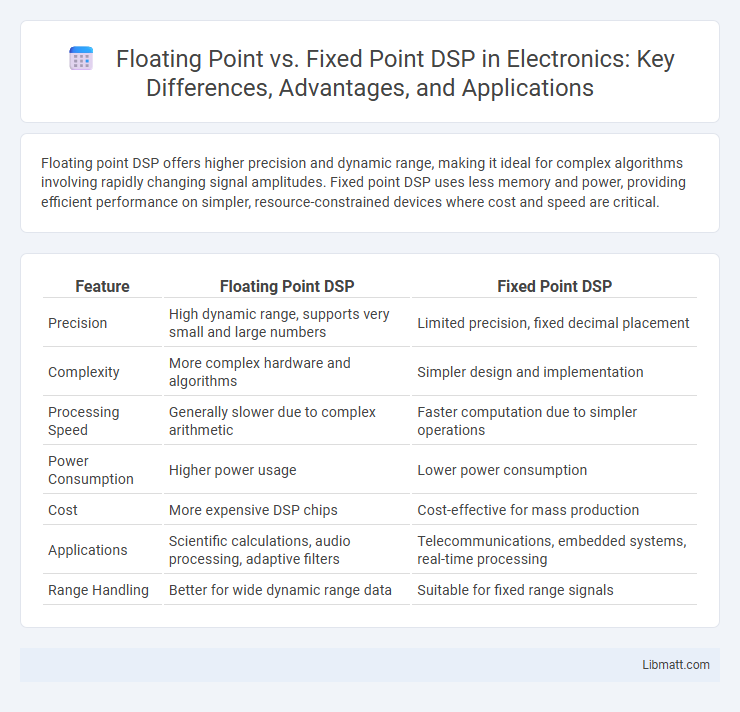Floating point DSP offers higher precision and dynamic range, making it ideal for complex algorithms involving rapidly changing signal amplitudes. Fixed point DSP uses less memory and power, providing efficient performance on simpler, resource-constrained devices where cost and speed are critical.
Table of Comparison
| Feature | Floating Point DSP | Fixed Point DSP |
|---|---|---|
| Precision | High dynamic range, supports very small and large numbers | Limited precision, fixed decimal placement |
| Complexity | More complex hardware and algorithms | Simpler design and implementation |
| Processing Speed | Generally slower due to complex arithmetic | Faster computation due to simpler operations |
| Power Consumption | Higher power usage | Lower power consumption |
| Cost | More expensive DSP chips | Cost-effective for mass production |
| Applications | Scientific calculations, audio processing, adaptive filters | Telecommunications, embedded systems, real-time processing |
| Range Handling | Better for wide dynamic range data | Suitable for fixed range signals |
Introduction to DSP Number Representations
Digital Signal Processing (DSP) utilizes floating point and fixed point number representations to handle numerical data efficiently, each offering distinct advantages for various applications. Floating point representation provides a wide dynamic range and precision by encoding numbers with a mantissa and an exponent, ideal for complex algorithms requiring high accuracy. Fixed point representation uses a fixed number of bits for the integer and fractional parts, offering faster computation and lower power consumption, making it suitable for resource-constrained embedded systems.
What Is Floating Point in DSP?
Floating point in DSP refers to a numerical representation that allows for a dynamic range by using a mantissa and an exponent, enabling accurate processing of very small or large values. This format is essential for complex signal processing tasks requiring high precision and reduced quantization errors. Your DSP applications benefit from floating point arithmetic by improving performance in audio, radar, and communication systems where numerical accuracy is critical.
What Is Fixed Point in DSP?
Fixed point in DSP refers to a numeric representation where numbers have a fixed number of digits before and after the decimal point, enabling efficient and fast arithmetic operations on hardware with limited resources. This format is commonly used in embedded systems and applications requiring low power consumption and high-speed processing, such as audio signal processing or control systems. You benefit from reduced computational complexity and memory usage compared to floating point, though at the cost of limited dynamic range and precision.
Key Differences Between Floating Point and Fixed Point DSP
Floating point DSP offers a wider dynamic range and higher precision, making it ideal for complex algorithms and applications requiring variable signal amplitudes. Fixed point DSP is more cost-effective and consumes less power, suitable for simpler tasks with a limited dynamic range and well-defined numerical limits. The choice between them depends on trade-offs between computational complexity, hardware resources, and application-specific accuracy requirements.
Precision and Dynamic Range Comparison
Floating point DSP offers significantly higher precision and a wider dynamic range compared to fixed point DSP, enabling accurate representation of very small and very large numbers without overflow or underflow issues. Fixed point DSP, while faster and more power-efficient, is limited by its fixed word length, resulting in quantization errors and a narrower dynamic range, which can impact performance in applications requiring high numerical accuracy. Floating point formats typically use 32-bit or 64-bit representations with mantissa and exponent, whereas fixed point uses integer arithmetic with a predetermined scaling factor.
Performance and Speed Considerations
Floating point DSPs offer higher precision and dynamic range, enabling faster processing of complex algorithms without overflow concerns, making them ideal for applications with variable signal amplitudes. Fixed point DSPs typically deliver faster execution speed and lower power consumption due to simpler hardware architecture, optimizing performance in cost-sensitive or real-time systems where precision requirements are moderate. Performance trade-offs depend on algorithm complexity, precision needs, and target application constraints, influencing the choice between floating and fixed point implementations.
Power Consumption and Resource Utilization
Floating point DSPs typically consume more power due to complex arithmetic units and increased switching activity, whereas fixed point DSPs offer lower power consumption by using simpler hardware and reduced bit-width operations. Resource utilization in floating point DSPs demands larger silicon area and more memory bandwidth to handle dynamic range and precision, while fixed point implementations efficiently use resources by optimizing word length for specific applications. Choosing fixed point design is advantageous for power-sensitive and resource-constrained environments, whereas floating point caters to high-precision signal processing tasks with relaxed power and area constraints.
Application Scenarios: When to Use Floating or Fixed Point
Floating point DSP is ideal for applications requiring high dynamic range and precision, such as audio processing, medical imaging, and scientific computations, where signal variance is significant. Fixed point DSP suits embedded systems with limited hardware resources, like automotive control and basic telecommunications, offering lower power consumption and faster execution. Your choice depends on the application's complexity, performance needs, and resource constraints to balance accuracy and efficiency.
Challenges in Implementing Floating and Fixed Point DSP
Implementing floating point DSP poses challenges such as higher power consumption and increased hardware complexity due to maintaining significant precision and dynamic range. Fixed point DSP, while more energy-efficient and faster on lower-cost processors, struggles with limited dynamic range and quantization errors that complicate algorithm design. Both approaches require careful consideration of precision, resource constraints, and application-specific performance requirements to optimize signal processing accuracy and efficiency.
Conclusion: Choosing the Right DSP Approach
Choosing between floating point and fixed point DSP depends on your application's precision and performance requirements. Floating point DSP offers higher dynamic range and easier programming, making it ideal for complex algorithms and audio processing. Fixed point DSP provides faster execution with lower power consumption, suitable for cost-sensitive and real-time embedded systems.
Floating point vs Fixed point DSP Infographic

 libmatt.com
libmatt.com